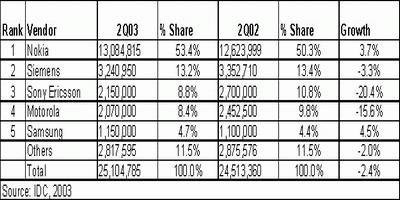
 A slow quarter for renewals and new subscribers hampered the Western European mobile phone market, which declined by 2.4 per cent year-on-year in the second quarter of 2003, according to IDC. Despite vendors offering increasingly diverse product portfolios, the mobile industry is facing the reality that a market driven by mobile phone replacements is tougher than one driven by new subscribers. According to Nokia‘s converged devices accounted for more than 5 per cent of its total sales, and its colour and integrated camera handsets such as the 7210 and 7250 have been well received in Western Europe.
A slow quarter for renewals and new subscribers hampered the Western European mobile phone market, which declined by 2.4 per cent year-on-year in the second quarter of 2003, according to IDC. Despite vendors offering increasingly diverse product portfolios, the mobile industry is facing the reality that a market driven by mobile phone replacements is tougher than one driven by new subscribers. According to Nokia‘s converged devices accounted for more than 5 per cent of its total sales, and its colour and integrated camera handsets such as the 7210 and 7250 have been well received in Western Europe.
“Although leading vendors have become increasingly adept at lowering their cost base and targeting end-users, increasing saturation means that new technologies are failing to stimulate greater demand among new subscribers for mobile phones in Europe, in what has essentially become a highly competitive renewal market,” commented Andrew Brown, program manager for European Mobile Devices at IDC.
Nokia continued to gain share from its three closest rivals in Western Europe in 2Q03. Motorola, Siemens and Sony Ericsson all declined in share, while Nokia‘s shipments grew in a market that showed a slight decline in comparison with the second quarter of 2002. Nokia ‘s success was ensured by its presence and innovation at all price points and effective targeting of its end-user base.
 Despite strong marketing of the small SL55 phone, Siemens still experienced a 3.3 per cent decline in unit shipments. Siemens‘ strong channel relationships and trusted brand have helped to cement its place as Europe‘s second handset vendor. These strengths, together with compelling new devices such as the Symbian Series 60 based SX1 and the innovative fashion brand Xelibri, are expected to maintain Siemens ‘ number 2 position
Despite strong marketing of the small SL55 phone, Siemens still experienced a 3.3 per cent decline in unit shipments. Siemens‘ strong channel relationships and trusted brand have helped to cement its place as Europe‘s second handset vendor. These strengths, together with compelling new devices such as the Symbian Series 60 based SX1 and the innovative fashion brand Xelibri, are expected to maintain Siemens ‘ number 2 position
“Since the hype, and subsequent disappointments, of 3G several years ago, the handsets, features, applications, bandwidth and networks have been built up to what can now be considered a realistic platform for next generation wireless technology to perform on,” said Matthew Dunn, research analyst for European Mobile Devices at IDC. “Handset growth should be driven by next-generation phones, which feature-hungry consumers are likely to include in their upgrade plans when the benefits are proven to them.”
Sony Ericsson, Nokia’s second biggest rival in Western Europe, ensured sequential growth with its new range of handsets, including the popular Japanese-designed T610. It also announced a range of feature phones this week, including the vendor’s Quickshare imaging, messaging and gaming phone.
The Z600, the customisable Z200 for the style-conscious, and the entertainment-focused T230. Also among the phones announced is the feature-rich HBH-200 Bluetooth wireless hands-free mobile phone. These new products are expected to impact its sales in the second half of this year. A particularly strong second quarter last year indicated its share and growth to be dropping significantly. However, according to IDC, sequentially the vendor’s performance was satisfactory, and should improve in the coming two quarters.
Motorola lost share both year-on-year and sequentially, but is the top-tier vendor with the most advanced 3G roadmap, which bodes well for its future. It already has an available device and the Symbian-based A290 has been officially announced.
According to IDC, Samsung “performed well, boasting market share increases both sequentially and year-on-year.” Its first bar-type camera phone with integrated flash, the SGH-E700 was recently launched in Germany and IDC expects a positive reception in the rest of Western Europe. Samsung continues to impact Motorola‘s share of the clamshell form factor phones, which are gaining rapidly in popularity in Europe.
The volumes of 3G handsets shipping remained relatively low during 2Q 2003 accounting for just over 1 per cent of all mobile phones shipped in Western Europe. NEC is the only vendor shipping in significant volumes.
2003-09-05
Em Foco – Produto

